-
 Bitcoin
Bitcoin $106,437.2012
0.82% -
 Ethereum
Ethereum $2,442.5287
0.82% -
 Tether USDt
Tether USDt $1.0005
-0.02% -
 XRP
XRP $2.1812
-0.27% -
 BNB
BNB $645.1327
0.45% -
 Solana
Solana $146.2379
0.39% -
 USDC
USDC $0.9999
-0.01% -
 TRON
TRON $0.2751
0.92% -
 Dogecoin
Dogecoin $0.1662
-0.23% -
 Cardano
Cardano $0.5827
-1.22% -
 Hyperliquid
Hyperliquid $37.5225
0.04% -
 Bitcoin Cash
Bitcoin Cash $479.0877
4.02% -
 Sui
Sui $2.7846
-3.27% -
 Chainlink
Chainlink $13.3576
0.84% -
 UNUS SED LEO
UNUS SED LEO $9.0252
-1.20% -
 Stellar
Stellar $0.2455
-1.07% -
 Avalanche
Avalanche $18.0680
-1.81% -
 Toncoin
Toncoin $2.8948
-1.07% -
 Shiba Inu
Shiba Inu $0.0...01164
-1.65% -
 Litecoin
Litecoin $85.0637
-0.06% -
 Hedera
Hedera $0.1526
-0.89% -
 Monero
Monero $316.2941
0.78% -
 Ethena USDe
Ethena USDe $1.0003
-0.04% -
 Polkadot
Polkadot $3.4113
-1.87% -
 Dai
Dai $1.0000
-0.01% -
 Bitget Token
Bitget Token $4.4488
5.16% -
 Uniswap
Uniswap $7.1740
3.09% -
 Pi
Pi $0.5968
11.43% -
 Pepe
Pepe $0.0...01010
-0.65% -
 Aave
Aave $264.3189
0.40%
How to interpret that RSI remains above 70 for three consecutive days without falling back?
When RSI stays above 70 for 3 days in crypto, it signals strong bullish momentum but requires confirmation from volume, trend, and broader market context to avoid false reversal signals.
Jun 24, 2025 at 11:14 pm
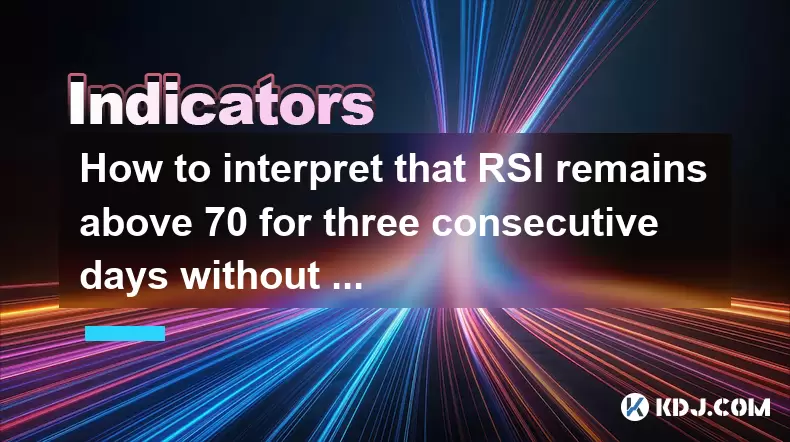
Understanding the RSI Indicator in Cryptocurrency Trading
The Relative Strength Index (RSI) is a momentum oscillator used to measure the speed and change of price movements. Typically, it ranges from 0 to 100 and is widely used by traders to identify overbought or oversold conditions in an asset. In cryptocurrency trading, where volatility is high and trends can reverse quickly, RSI plays a crucial role in technical analysis.
When the RSI remains above 70 for three consecutive days, this signals that the asset has been consistently overbought during this period. Normally, an RSI reading above 70 suggests that the asset may be overextended on the upside and could face downward pressure soon. However, if the RSI doesn't drop below 70 despite multiple sessions, it requires deeper interpretation.
Potential Implications of Sustained RSI Above 70
A prolonged RSI above 70 can indicate several possible market dynamics:
- The bullish momentum is strong and buyers are continuously entering the market.
- There may be ongoing positive sentiment or news driving consistent demand.
- The market might be in a parabolic phase, especially common in cryptocurrencies during bull runs.
In traditional markets, such readings often precede pullbacks. However, in crypto, due to its speculative nature and high volatility, assets can remain overbought for extended periods. Therefore, traders must not rely solely on RSI but also consider volume, candlestick patterns, and broader market context.
Distinguishing Between Healthy Bull Runs and Overheated Markets
It's essential to differentiate between a healthy continuation of a bullish trend and a potentially unsustainable rally:
- If price continues to make higher highs with increasing volume, the overbought RSI may reflect real strength rather than weakness.
- Conversely, if volume declines while RSI stays elevated, it could signal weakening participation and potential exhaustion.
Traders should also look at divergence between RSI and price action. For instance, if the price makes new highs but RSI fails to surpass its previous high, it could hint at a reversal even when RSI remains above 70.
How to Use RSI in Conjunction With Other Indicators
Using RSI in isolation can lead to misleading signals. Combining it with other tools enhances decision-making accuracy:
- Moving Averages: Overlaying moving averages like the 20-day or 50-day MA can help confirm trend strength.
- MACD (Moving Average Convergence Divergence): Helps assess whether momentum is still supporting the current trend.
- Volume Analysis: Rising volume supports continued uptrend; falling volume warns of potential reversal.
For example, if the MACD line remains above the signal line and the histogram is expanding while RSI is above 70, it strengthens the case for ongoing bullish momentum.
Practical Steps for Responding to Persistent Overbought RSI
Here’s how traders can approach a situation where RSI stays above 70 for three consecutive days:
- Monitor Price Action Closely: Look for signs of rejection at resistance levels or bearish candlestick patterns.
- Assess Market News and Events: Positive developments like exchange listings or partnerships can justify sustained overbought conditions.
- Set Trailing Stops: If already holding a long position, trailing stops can protect profits without prematurely exiting.
- Avoid Shorting Based on RSI Alone: Especially in crypto, shorting an overbought asset without confirmation can be risky.
- Use Timeframes Strategically: Check RSI across multiple timeframes (daily, 4-hour) to see if the condition holds uniformly or appears only in one.
This multi-step approach ensures traders don’t act impulsively and instead make calculated decisions based on broader context.
Common Misinterpretations and Pitfalls
Many traders fall into the trap of treating RSI as a standalone tool. Some common mistakes include:
- Assuming a Reversal Is Imminent Just Because RSI Is Overbought
- Ignoring Trend Direction and Applying RSI the Same Way in All Market Conditions
- Failing to Account for Bitcoin Dominance and Macro Influences
Especially in altcoin markets, if Bitcoin is rallying strongly, many altcoins will follow regardless of their individual RSI readings. Hence, understanding the broader ecosystem is key.
Frequently Asked Questions (FAQ)
Q: Can RSI stay above 70 for more than three days?
Yes, especially in strong uptrends or during market euphoria phases. This is particularly common in crypto bull markets where FOMO (fear of missing out) drives continuous buying pressure.
Q: Should I sell my holdings if RSI stays above 70 for three days?
Not necessarily. It depends on other indicators and your investment strategy. Some traders use RSI above 70 as a sign to hold or even add to positions if other signals support strength.
Q: Does RSI behave differently for different cryptocurrencies?
Yes. Larger-cap coins like Bitcoin and Ethereum tend to have more stable RSI behavior compared to smaller altcoins, which can show exaggerated RSI swings due to lower liquidity and higher volatility.
Q: How does timeframe affect RSI interpretation?
RSI values vary significantly across timeframes. A daily RSI above 70 might indicate strong bullish control, while a 1-hour RSI might show overextension within that larger trend. Always cross-check across timeframes before making decisions.
Disclaimer:info@kdj.com
The information provided is not trading advice. kdj.com does not assume any responsibility for any investments made based on the information provided in this article. Cryptocurrencies are highly volatile and it is highly recommended that you invest with caution after thorough research!
If you believe that the content used on this website infringes your copyright, please contact us immediately (info@kdj.com) and we will delete it promptly.
- Bitcoin Price Soars to $106,596: Is This the Recovery We've Been Waiting For?
- 2025-06-25 12:25:14
- XRP Ledger's New Era: Batch Transactions and Token Escrow Take Center Stage
- 2025-06-25 12:45:12
- JasmyCoin: Price Prediction & the Quest for New Highs
- 2025-06-25 12:25:14
- Arctic Pablo Coin: The Meme Coin Primed for Lift-Off? Plus, Bonk & SHIB Updates!
- 2025-06-25 12:45:12
- BigBear.ai, AMD, QuantumScape: Stocks Soar and Solid-State Batteries Get Real!
- 2025-06-25 12:50:13
- Bitcoin, Ethereum, and the Iran-Israel Ceasefire: A Crypto Market Update
- 2025-06-25 13:05:13
Related knowledge
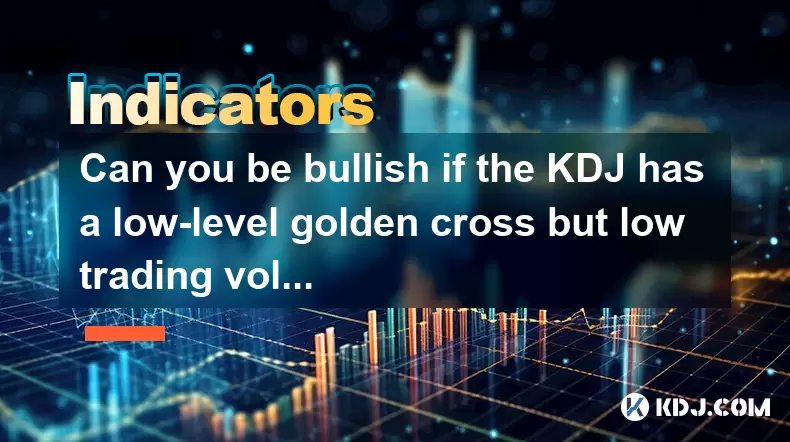
Can you be bullish if the KDJ has a low-level golden cross but low trading volume?
Jun 25,2025 at 03:14pm
Understanding the KDJ Indicator in Cryptocurrency TradingThe KDJ indicator, also known as the stochastic oscillator, is a momentum-based technical analysis tool widely used in cryptocurrency trading. It comprises three lines: the %K line (fast stochastic), the %D line (slow stochastic), and the J line (divergence value). These lines oscillate between 0 ...
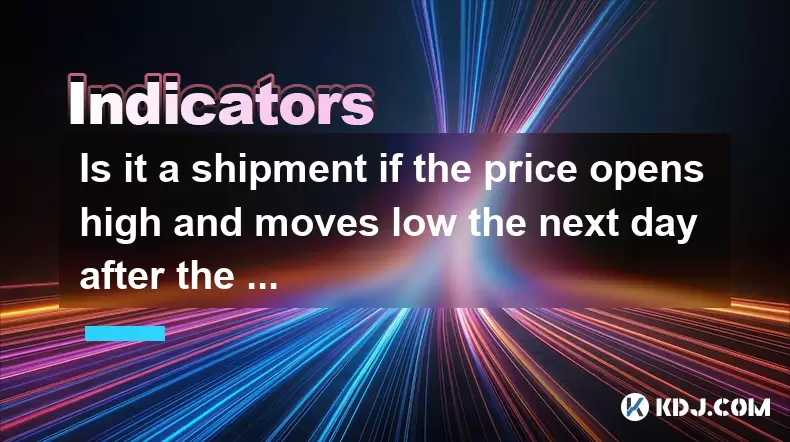
Is it a shipment if the price opens high and moves low the next day after the daily limit with huge volume?
Jun 25,2025 at 12:56pm
Understanding the Concept of a Shipment in Cryptocurrency TradingIn cryptocurrency trading, the term shipment refers to a scenario where large volumes of an asset are sold off rapidly, often leading to a significant price drop. This is typically associated with whale activity or coordinated selling by major holders. When traders observe certain patterns...
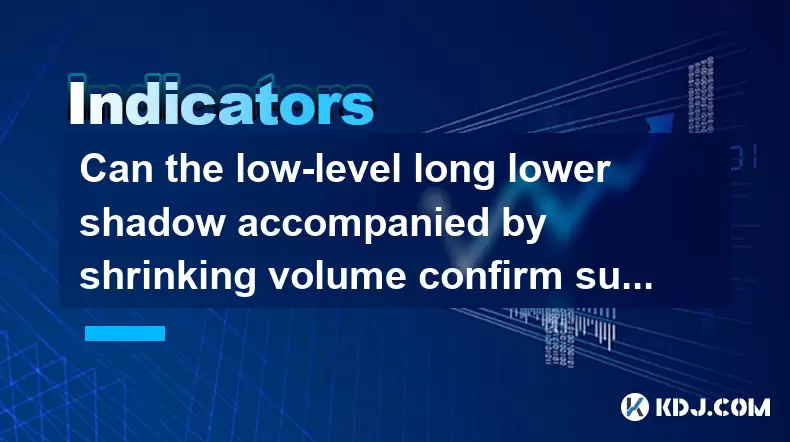
Can the low-level long lower shadow accompanied by shrinking volume confirm support?
Jun 25,2025 at 03:08pm
Understanding the Long Lower Shadow Candlestick PatternA long lower shadow candlestick pattern occurs when a candle closes near its high but has a significantly long lower wick, indicating that sellers pushed prices down during the session but were met with strong buying pressure that drove the price back up. This pattern is often seen as a potential si...
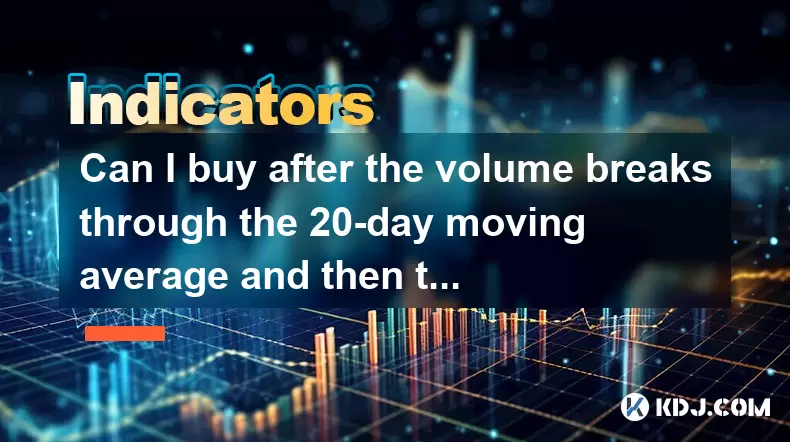
Can I buy after the volume breaks through the 20-day moving average and then the volume shrinks and then the callback is pulled back?
Jun 25,2025 at 12:00pm
Understanding Volume and Moving Averages in Cryptocurrency TradingIn the world of cryptocurrency trading, volume and moving averages are two critical indicators that traders rely on to make informed decisions. The 20-day moving average (MA) is a popular tool used to identify trends and potential entry or exit points. When volume breaks through this aver...
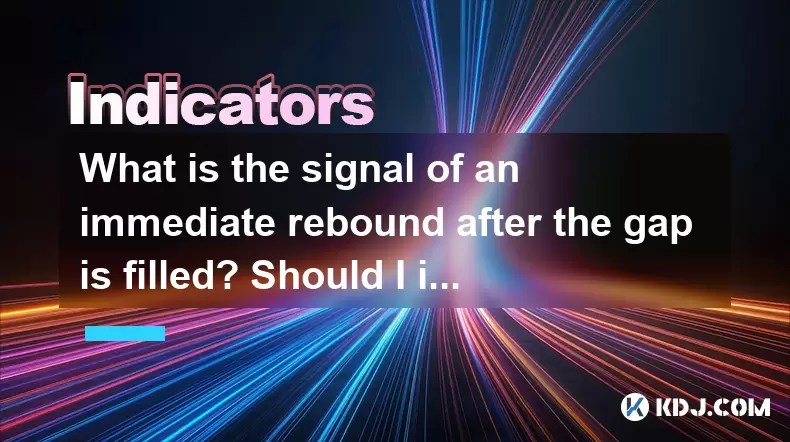
What is the signal of an immediate rebound after the gap is filled? Should I intervene?
Jun 25,2025 at 01:15pm
Understanding Gaps in Cryptocurrency TradingIn cryptocurrency trading, a gap occurs when the price of an asset jumps from one level to another without any trading happening in between. This typically happens during periods of high volatility or after significant news events that impact market sentiment overnight or over weekends. The phenomenon is commo...
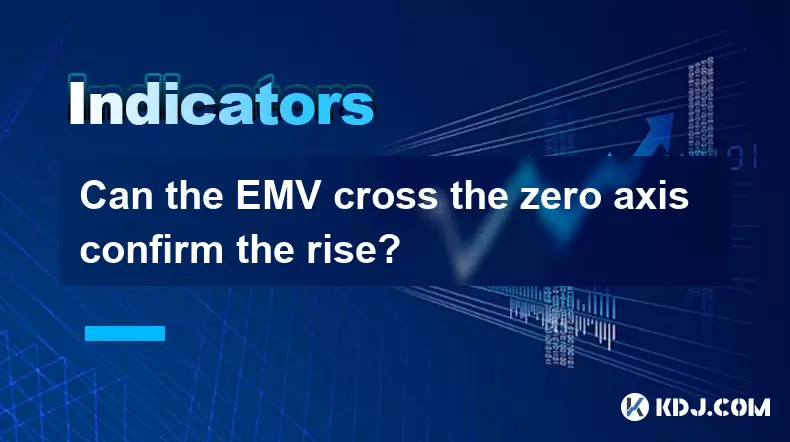
Can the EMV cross the zero axis confirm the rise?
Jun 25,2025 at 11:14am
Understanding the EMV Indicator in Cryptocurrency TradingThe Ease of Movement Value (EMV) is a technical analysis indicator commonly used by traders to assess the relationship between price and volume. In the cryptocurrency market, where volatility is high and trends can reverse quickly, understanding how to interpret EMV becomes crucial for making info...

Can you be bullish if the KDJ has a low-level golden cross but low trading volume?
Jun 25,2025 at 03:14pm
Understanding the KDJ Indicator in Cryptocurrency TradingThe KDJ indicator, also known as the stochastic oscillator, is a momentum-based technical analysis tool widely used in cryptocurrency trading. It comprises three lines: the %K line (fast stochastic), the %D line (slow stochastic), and the J line (divergence value). These lines oscillate between 0 ...

Is it a shipment if the price opens high and moves low the next day after the daily limit with huge volume?
Jun 25,2025 at 12:56pm
Understanding the Concept of a Shipment in Cryptocurrency TradingIn cryptocurrency trading, the term shipment refers to a scenario where large volumes of an asset are sold off rapidly, often leading to a significant price drop. This is typically associated with whale activity or coordinated selling by major holders. When traders observe certain patterns...

Can the low-level long lower shadow accompanied by shrinking volume confirm support?
Jun 25,2025 at 03:08pm
Understanding the Long Lower Shadow Candlestick PatternA long lower shadow candlestick pattern occurs when a candle closes near its high but has a significantly long lower wick, indicating that sellers pushed prices down during the session but were met with strong buying pressure that drove the price back up. This pattern is often seen as a potential si...

Can I buy after the volume breaks through the 20-day moving average and then the volume shrinks and then the callback is pulled back?
Jun 25,2025 at 12:00pm
Understanding Volume and Moving Averages in Cryptocurrency TradingIn the world of cryptocurrency trading, volume and moving averages are two critical indicators that traders rely on to make informed decisions. The 20-day moving average (MA) is a popular tool used to identify trends and potential entry or exit points. When volume breaks through this aver...

What is the signal of an immediate rebound after the gap is filled? Should I intervene?
Jun 25,2025 at 01:15pm
Understanding Gaps in Cryptocurrency TradingIn cryptocurrency trading, a gap occurs when the price of an asset jumps from one level to another without any trading happening in between. This typically happens during periods of high volatility or after significant news events that impact market sentiment overnight or over weekends. The phenomenon is commo...

Can the EMV cross the zero axis confirm the rise?
Jun 25,2025 at 11:14am
Understanding the EMV Indicator in Cryptocurrency TradingThe Ease of Movement Value (EMV) is a technical analysis indicator commonly used by traders to assess the relationship between price and volume. In the cryptocurrency market, where volatility is high and trends can reverse quickly, understanding how to interpret EMV becomes crucial for making info...
See all articles
























































































